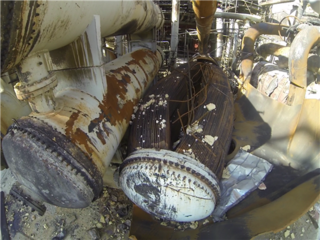
Texas City is a city in Galveston County, Texas, United States. Located on the southwest shoreline of Galveston Bay, Texas City is a busy deepwater port on Texas's Gulf Coast, as well as a petroleum-refining and petrochemical-manufacturing center. The population was 51,898 at the 2020 census, making it the third-largest city in Galveston County, behind League City and Galveston. It is a part of the Houston metropolitan area. The city is notable as the site of a major explosion in 1947 that demolished the port and much of the city.

An oil refinery or petroleum refinery is an industrial process plant where petroleum is transformed and refined into products such as gasoline (petrol), diesel fuel, asphalt base, fuel oils, heating oil, kerosene, liquefied petroleum gas and petroleum naphtha. Petrochemical feedstock like ethylene and propylene can also be produced directly by cracking crude oil without the need of using refined products of crude oil such as naphtha. The crude oil feedstock has typically been processed by an oil production plant. There is usually an oil depot at or near an oil refinery for the storage of incoming crude oil feedstock as well as bulk liquid products. In 2020, the total capacity of global refineries for crude oil was about 101.2 million barrels per day.

A boiling liquid expanding vapor explosion is an explosion caused by the rupture of a vessel containing a pressurized liquid that is or has reached a temperature sufficiently higher than its boiling point. Because the boiling point of a liquid rises with pressure, the contents of the pressurized vessel can remain a liquid as long as the vessel is intact. If the vessel's integrity is compromised, the loss of pressure drops the boiling point, which can cause the liquid to convert to gas expanding rapidly. BLEVEs are manifestations of explosive boiling.

A confined space is a space with limited entry and egress and not suitable for human inhabitants. An example is the interior of a storage tank, occasionally entered by maintenance workers but not intended for human occupancy. Hazards in a confined space often include harmful dust or gases, asphyxiation, submersion in liquids or free-flowing granular solids, electrocution, or entrapment.

A chemical plant is an industrial process plant that manufactures chemicals, usually on a large scale. The general objective of a chemical plant is to create new material wealth via the chemical or biological transformation and or separation of materials. Chemical plants use specialized equipment, units, and technology in the manufacturing process. Other kinds of plants, such as polymer, pharmaceutical, food, and some beverage production facilities, power plants, oil refineries or other refineries, natural gas processing and biochemical plants, water and wastewater treatment, and pollution control equipment use many technologies that have similarities to chemical plant technology such as fluid systems and chemical reactor systems. Some would consider an oil refinery or a pharmaceutical or polymer manufacturer to be effectively a chemical plant.

LyondellBasell Industries N.V. is an American multinational chemical company incorporated in the Netherlands with U.S. operations headquartered in Houston, Texas, and offices in London, UK. The company is the largest licensor of polyethylene and polypropylene technologies. It also produces ethylene, propylene, polyolefins, and oxyfuels.

The Pine Bend Refinery is the largest oil refinery in Minnesota, located in the Twin Cities suburbs of Rosemount and Inver Grove Heights next to southern split of U.S. Highway 52 and Minnesota State Highway 55. The refinery is notable for being the largest in the United States to be located in a state without any oil wells. Overall, it ranked 14th in the country as of 2012 by production, with a nameplate capacity of 320,000 barrels (51,000 m3) per day. The facility is owned by Flint Hills Resources (FHR), a subsidiary of Koch Industries.

The Texas City refinery explosion occurred on March 23, 2005, when a flammable hydrocarbon vapor cloud ignited and violently exploded at the isomerization process unit of the BP oil refinery in Texas City, Texas, killing 15 workers, injuring 180 others and severely damaging the refinery. All the fatalities were contractors working out of temporary buildings located close to the unit to support turnaround activities. Property loss was $200 million. When including costs of repairs, deferred production, fines, and settlements, the explosion is the world's costliest refinery accident.

Bayway Refinery is a refining facility in the Port of New York and New Jersey, owned by Phillips 66. Located in Linden and Elizabeth, New Jersey, and bisected by Morses Creek, it is the northernmost refinery on the East Coast of the United States. The oil refinery converts crude oil into gasoline, diesel fuel, jet fuel, propane and heating oil. As of 2007, the facility processed approximately 238,000 bbl/d (37,800 m3/d) of crude oil, producing 145,000 bbl/d (23,100 m3/d) of gasoline and 110,000 bbl/d (17,000 m3/d) of distillates. Its products are delivered to East Coast customers via pipeline transport, barges, railcars and tank trucks.

Operating as Houston Refining, LP, LyondellBasell's Houston refinery is a 268,000-barrel-per-day (42,600 m3/d) refinery located on the Texas Gulf Coast in Houston that occupies 700 acres (2.8 km2) along the Houston Ship Channel. This refinery has been in operation since 1918, and it currently produces gasoline, lubricant base stock, propylene, and other associated materials. LyondellBasell has announced its intention to close this refinery by 2023, to help it reach its climate-change goals.
On 23 October, 1989 at approximately 1:05 PM Central Daylight Time, a series of explosions occurred at Phillips Petroleum Company's Houston Chemical Complex in Pasadena, Texas, near the Houston Ship Channel. The initial blast registered 3.5 on the Richter scale, and the resulting fires took 10 hours to bring under control, as efforts to battle the fire were hindered due to damaged water pipes for the fire hydrants from the blast. The initial explosion was found to have resulted from a release of extremely flammable process gasses used to produce high-density polyethylene, a plastic used for various consumer food container products. The US Occupational Safety and Health Administration fined Phillips Petroleum Company $5,666,200 and fined Fish Engineering and Construction, inc, the maintenance contractor, $729,600. The event killed 23 employees and injured 314.

At approximately 1:22 p.m. CT on March 27, 2000, an explosion and fire responsible for one death and 71 injuries occurred at Phillips Petroleum's Houston Chemical Complex at 1400 Jefferson Road in Pasadena, Texas. The fire produced huge plumes of black smoke that spread over the heavily industrialized Houston Ship Channel and neighboring residential areas.

On 7 February 2008, fourteen people were killed and thirty six injured during a dust explosion at a refinery owned by Imperial Sugar in Port Wentworth, Georgia, United States. Dust explosions had been an issue of concern among U.S. authorities since three fatal accidents in 2003, with efforts made to improve safety and reduce the risk of reoccurrence.

BP p.l.c. is a British multinational oil and gas company headquartered in London, England. It is one of the oil and gas "supermajors" and one of the world's largest companies measured by revenues and profits. It is a vertically integrated company operating in all areas of the oil and gas industry, including exploration and extraction, refining, distribution and marketing, power generation, and trading.

The Chevron Richmond Refinery is a 2,900-acre (1,200 ha) petroleum refinery in Richmond, California, on San Francisco Bay. It is owned and operated by Chevron Corporation and employs more than 1,200 workers, making it the city's largest employer. The refinery processes approximately 240,000 barrels (38,000 m3) of crude oil a day in the manufacture of petroleum products and other chemicals. The refinery's primary products are motor gasoline, jet fuel, diesel fuel and lubricants.

The Williams Olefins Plant explosion occurred on June 13, 2013 at a petrochemical plant located in Geismar, an unincorporated and largely industrial area 20 miles (32 km) southeast of Baton Rouge, Louisiana. Two workers were killed and 114 injured. The U.S. Occupational Safety and Health Administration (OSHA) and the U.S. Chemical Safety and Hazard Investigation Board (CSB) launched investigations to determine how and why the heat exchanger failed. The Chemical Safety Board concluded that a standby heat exchanger had filled with hydrocarbon. This heat exchanger was isolated from its pressure relief; shortly after the heat exchanger was heated with hot water, the hydrocarbon flashed to vapor, ruptured the heat exchanger, and exploded.
TPC Group, previously known as Texas Petrochemicals, is a petrochemicals manufacturing company based in Houston, Texas, and is a large producer of butadiene, MTBE, and polyisobutylene. TPC has operations in Houston and Port Neches, Texas, and Lake Charles, Louisiana.
The 2021 Georgia poultry plant accident was an industrial disaster that occurred on January 28, 2021, in Gainesville, Georgia, United States. Six people were killed by asphyxiation and at least ten were injured when a liquid nitrogen leak occurred inside a poultry processing plant owned by Foundation Food Group.















